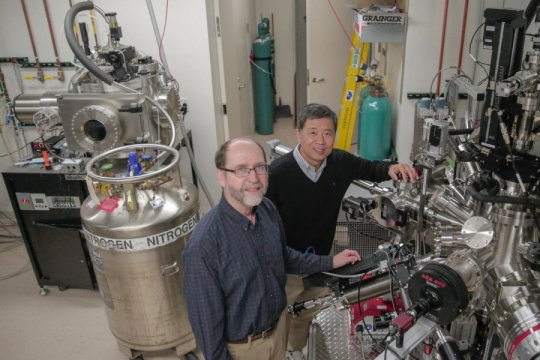[ad_1]
University of Wisconsin-Madison researchers have made a material that can transition from an electricity-transmitting metal to a nonconducting insulating material without changing its atomic structure.
“This is quite an exciting discovery,” says Chang-Beom Eom, professor of materials science and engineering. “We’ve found a new method of electronic switching.”
The new material could lay the groundwork for ultrafast electronic devices. Eom and his international team of collaborators published details of their advance today (Nov. 30, 2018) in the journal Science.
Metals like copper or silver conduct electricity, whereas insulators like rubber or glass do not allow current to flow. Some materials, however, can transition from insulating to conducting.
This transition usually means that the arrangement of a material’s atoms and its conducting electrons must change in a coordinated way, but the atomic transition typically proceeds much more slowly than the smaller, lighter electrons that conduct electricity.
A material that can switch to conducting electricity like a metal without moving its atoms could dramatically advance switching speeds of advanced devices, says Eom.
“The metal-to-insulator transition is very important for switches and for logic devices with a one or a zero state,” he says. “We have the potential to use this concept to make very fast switches.”
In their research, Eom and his collaborators answered a fundamental question that has bothered scientists for years: Can the electronic and structural transition be decoupled — essentially, can the quickly changing electrons break out on their own and leave the atoms behind?
They used a material called vanadium dioxide, which is a metal when it’s heated and an insulator when it’s at room temperature. At high temperatures, the atoms that make up vanadium dioxide are arranged in a regularly repeating pattern that scientists refer to as the rutile phase. When vanadium dioxide cools down to become an insulator, its atoms adopt a different pattern, called monoclinic.
No naturally occurring substances conduct electricity when their atoms are in the monoclinic conformation. And it takes time for the atoms to rearrange when a material reaches the insulator-to-metal transition temperature.
Crucially, vanadium dioxide transitions between a metal and an insulator at different temperatures depending upon the amount of oxygen present in the material. The researchers leveraged that fact to create two thin layers of vanadium dioxide — one with a slightly lower transition temperature than the other — sandwiched on top of each other, with a sharp interface between.
When they heated the thin vanadium dioxide sandwich, one layer made the structural switch to become a metal. Atoms in the other layer remained locked into the insulating monoclinic phase. Surprisingly, however, that part of the material conducted electricity.
Most importantly, the material remained stable and retained its unique characteristics.
Although other research groups have attempted to create electrically conductive insulators, those materials lost their properties almost instantly — persisting for mere femtoseconds, or a few thousandths of one trillionth of a second.
The Eom team’s material, however, is here to stay.
“We were able to stabilize it, making it useful for real devices,” says Eom.
Key to their approach was the dual-layer, sandwich structure. Each layer was so thin that the interface between the two materials dominated how the entire stack behaved. It’s a notion that Eom and colleagues plan to pursue further.
“Designing interfaces could open up new materials,” says Eom.
The Wisconsin Alumni Research Foundation is assisting the researchers with patent filing.
Story Source:
Materials provided by University of Wisconsin-Madison. Note: Content may be edited for style and length.
[ad_2]















